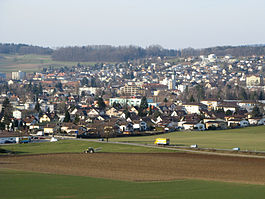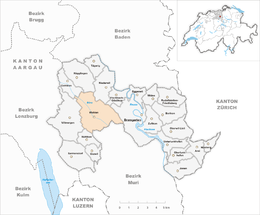Wohlen
| Wohlen | ||
|---|---|---|
 |
||
|
||
| Coordinates: 47°21′N 8°17′E / 47.350°N 8.283°ECoordinates: 47°21′N 8°17′E / 47.350°N 8.283°E | ||
| Country | Switzerland | |
| Canton | Aargau | |
| District | Bremgarten | |
| Area | ||
| • Total | 12.48 km2 (4.82 sq mi) | |
| Elevation | 421 m (1,381 ft) | |
| Population (Dec 2015) | ||
| • Total | 15,600 | |
| • Density | 1,300/km2 (3,200/sq mi) | |
| Postal code | 5610 | |
| SFOS number | 4082 | |
| Surrounded by | Bremgarten, Büttikon, Dottikon, Fischbach-Göslikon, Hägglingen, Niederwil, Villmergen, Waltenschwil | |
| Twin towns | Lermoos (Austria) | |
| Website |
www SFSO statistics |
|
Wohlen is a municipality in the district of Bremgarten in the canton of Aargau in Switzerland.
The earliest known settlements in Wohlen date from the late Hallstatt era (600-500 BC). This settlement left two clusters of burial mounds in Hohbühl and Häslerhau. While the graves were discovered and excavated in 1925-1930, the location of the settlement is still unknown. During the Roman era two large estates were built at Oberdorf and the Brünishalde. Both estates date from about 50 AD and supported a number of fields. The harvested grain was probably for the maintenance of the Roman troops at the military camp Vindonissa. Of the estates all that remains is masonry, tile, mosaic pieces and coins, as well as some foundations at Häslerhau.
During the migration of the Alemanni in the 5th Century into the area, they built their own settlements to the right of the Bünz in Chappele, Steingasse, Kirche and along the upper main street as well as along the left bank of the Bünz in Wil. The local gallic population merged slowly with the Germanic Alemanni. With the migration of the Germanic tribe, the place name became Wohlen. The name is first mentioned in 1178/79 as Vuolon / Volen, and goes back to the Old High German Walh, which means Vlachs or , a term for the romanized locals. So, the Alemannic name of Vuolon / Volen referred to the earlier inhabitants.
One of the reasons for the slow integration of the two populations was the lack of an ecclesiastical center. Wohlen had no parish church, but was split between three parishs, Niederwil, Göslikon and Villmergen. Shortly after 1100, an ancestor of the Lords of Volen donated a small church to the village. This church served until 1518 but didn't include the whole population. The lords of Volen (1185–1425) were the largest landowners in the village and the only local family who made the leap from the peasantry into the Habsburg military nobility. Even among the general population, there were "rich" with more fields, meadows, and cattle and the poor who worked on the neighbor's fields.
...
Wikipedia




